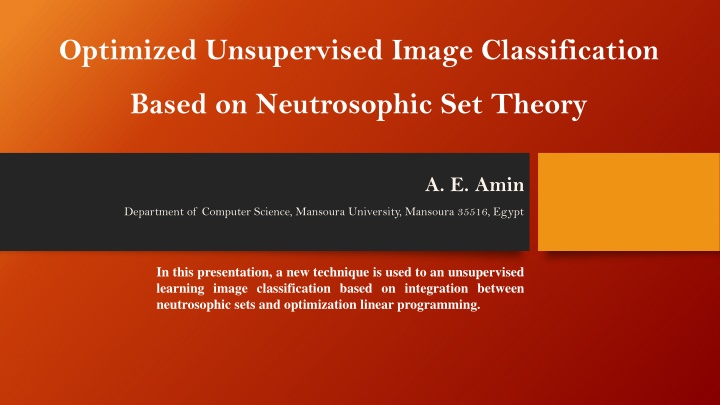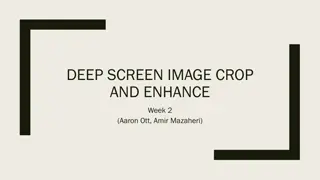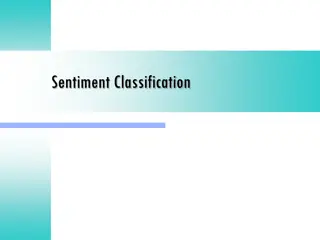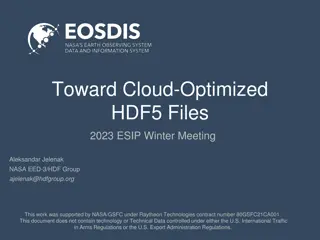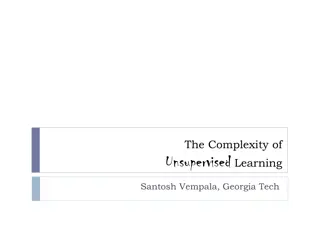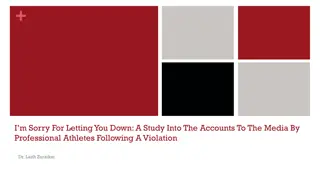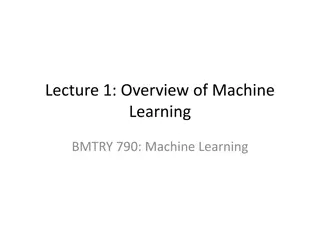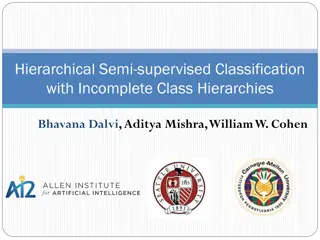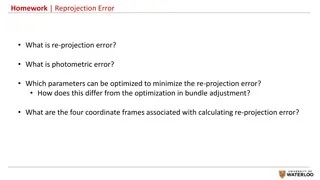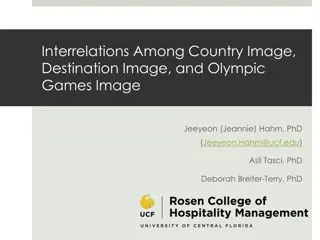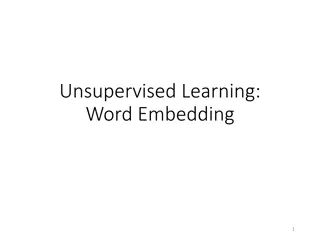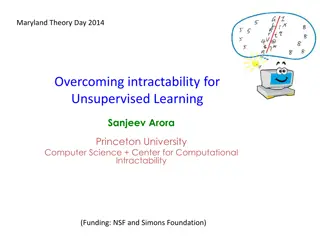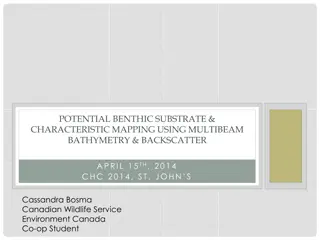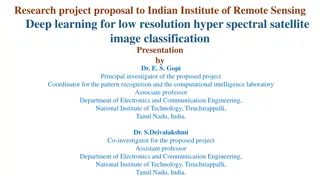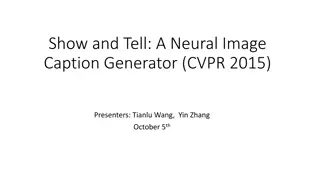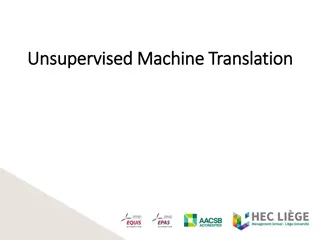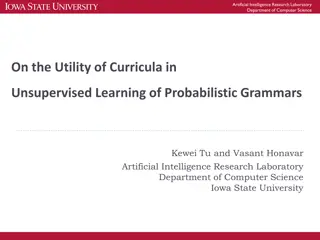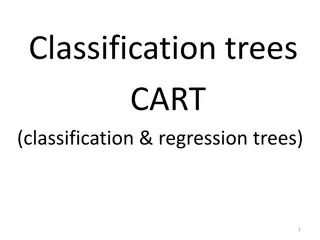Optimized Unsupervised Image Classification Based on Neutrosophic Set Theory
Neutrosophic sets are utilized for image segmentation into objects, edges, and background components, addressing the problem of overlapping in image classification through optimization linear programming. Computer vision advancements have led to the development of various algorithms, including unsupervised learning methods for categorizing data into distinct classes.
Uploaded on Mar 13, 2025 | 2 Views
Download Presentation

Please find below an Image/Link to download the presentation.
The content on the website is provided AS IS for your information and personal use only. It may not be sold, licensed, or shared on other websites without obtaining consent from the author.If you encounter any issues during the download, it is possible that the publisher has removed the file from their server.
You are allowed to download the files provided on this website for personal or commercial use, subject to the condition that they are used lawfully. All files are the property of their respective owners.
The content on the website is provided AS IS for your information and personal use only. It may not be sold, licensed, or shared on other websites without obtaining consent from the author.
E N D
Presentation Transcript
Optimized Unsupervised Image Classification Based on Neutrosophic Set Theory A. E. Amin Department of Computer Science, Mansoura University, Mansoura 35516, Egypt In this presentation, a new technique is used to an unsupervised learning image classification based on integration between neutrosophic sets and optimization linear programming.
Abstract. Neutrosophic sets are used to segment the image into three main components namely objects (O), edges (E), and Background (B). The neutrosophic image components (O,E,B) are corresponding to the neutrosophic sets components (T, I ,F). The components of neutrosophic image valued in [-0,1+] are representing the association intensities degree of pixel for each image components. Netrosophic image components are contributed to solving one of the important problems in image classification known as "overlapping" within cluster. While, the problem of overlapping between clusters is solved by using optimization linear programming.
Introduction. Since several decades, the world is witnessing a remarkable development in the science of computer vision. The principle of computer vision is based on deal with the images and methods of treatment. Hence the interest of researchers in the computer vision with image processing, which is concerned, in essence, on the methods and many different algorithms. Among these algorithms are image classification algorithms. Classification is the field devoted to the study of methods designed to categorize data into distinct classes.
Introduction - cont. This categorization can be divided to distinct labeling of the data (supervised learning [1]), division of the data into classes (unsupervised learning [2]), selection of the most significant features of the data (feature selection [3]), or a combination of more than one of these tasks [4]. [1] Lu, Dengsheng, and Qihao Weng. "A survey of image classification methods and techniques for improving classification performance.", International journal of Remote sensing 28.5 (2007): 823- 870. [2] Lee, Te-Won, and Michael S. Lewicki. "Unsupervised image classification, segmentation, and enhancement using ICA mixture models." Image Processing, IEEE Transactions on 11, no. 3 (2002): 270-279. [3] Guyon, Isabelle, and Andr Elisseeff. "An introduction to variable and feature selection." The Journal of Machine Learning Research 3 (2003): 1157-1182. [4] Saeys, Yvan, I aki Inza, and Pedro Larra aga. "A review of feature selection techniques in bioinformatics." bioinformatics 23.19 (2007): 2507-2517.
Introduction - cont. Unsupervised image classification (UIC) starts by partitioning the image data into groups (or clusters). The classes in UIC are unknown, according to similarity measure, groups of image data can be compared with reference to data by an analyst [5]. UIC can be categorized into two main groups namely Hierarchical [6] and Partitional [7] algorithms. [5] Omran, Mahamed GH, Andries Petrus Engelbrecht, and Ayed Salman."Differential evolution methods for unsupervised image classification." Evolutionary Computation, 2005. The 2005 IEEE Congress on. Vol. 2. IEEE, 2005. [6] Deng, Jia, Alexander C. Berg, Kai Li, and Li Fei-Fei. "What does classifying more than 10,000 image categories tell us?" In Computer Vision ECCV 2010, pp. 71-84. Springer Berlin Heidelberg, 2010. [7] Yang, Shulin, Liefeng Bo, Jue Wang, and Linda G. Shapiro. "Unsupervised Template Learning for Fine-Grained Object Recognition." In NIPS, pp. 3131-3139. 2012.
Introduction - cont. In hierarchical clustering algorithms (HCA) a sequence of clustering with each clustering being a partition of the data set are showing as a tree [8]. [8] Murtagh, Fionn, and Pedro Contreras. "Algorithms for hierarchical clustering: an overview." Wiley Interdisciplinary Reviews: Data Mining and Knowledge Discovery 2.1 (2012): 86-97. HCA is characterized by two advantages, first the number of classes does not need be specified a priori and the others they are independent of th initial condition. However, HCA is suffers from be a static algorithm and its inability to solve the overlapping clusters problem [9]. [9] Elavarasi, S. Anitha, J. Akilandeswari, and B. Sathiyabhama. "A survey on partition clustering algorithms." learning 1.1 (2011).
Introduction - cont. HCA are divided according to the clusters construction methods or according to the similarity measure. For methods construct the clusters by recursively partitioning the instances in either a top-down or bottom-up fashion. These methods can be subdivided as agglomerative [10] and divisive [11] methods. [10] Meila, Marina, and David Heckerman. "An experimental comparison of several clustering and initialization methods." arXiv preprint arXiv:1301.7401 (2013). [11] Gaidon, Adrien, Zaid Harchaoui, and Cordelia Schmid. "Recognizing activities with cluster- trees of tracklets." BMVC. 2012. Whereas, the merging or division of clusters is performed according to some similarity measure, chosen so as to optimize some criterion (such as a sum of squares). The hierarchical clustering methods could be further divided according to the manner that the similarity measure is calculated [12]. [12] Jain, A.K. Murty, M.N. and Flynn, P.J. Data Clustering: A Survey. ACM Computing Surveys, Vol. 31, No. 3, September 1999.
Introduction - cont. On the other hand, partitional clustering algorithms (PCA) are based on image data set segmentation into a specified number of clusters. PCA can be treated as an optimization problem as a result of reliance on the square error function to minimize certain criteria. Both HCA and PCA algorithms are participate in advantages and drawbacks. There are two categories from PCA namely Iterative [13] and non-iterative [14] algorithms. [13] Dong, Weisheng, et al. "Sparsity-based image denoising via dictionary learning and structural clustering." Computer Vision and Pattern Recognition (CVPR), 2011 IEEE Conference on. IEEE, 2011. [14] Hanauer, Matthias, and Andreas Koehn. "Perturbative treatment of triple excitations in internally contracted multireference coupled cluster theory." The Journal of chemical physics 136.20 (2012): 204107.
Introduction - cont. K-means algorithm [15] is the most widely used in iterative partitional algorithms. [15] Zhao, Z. L., Bo Liu, and Wei Li. "Image clustering based on extreme K-means algorithm." IEIT Journal ofAdaptive & Dynamic Computing 2012.1 (2012): 12-16. The basic idea for k-means algorithm is to find a clustering structure that minimizes a certain error criterion which easures the distance of each instance to its representative value. The most well-known criterion is the Sum of Squared Error (SSE) [16], may be globally optimized by exhaustively enumerating all partitions, which is very time-consuming, or by giving an approximate solution using heuristics. [16] Celebi, M. Emre, Hassan A. Kingravi, and Patricio A. Vela. "A comparative study of efficient initialization methods for the k-means clustering algorithm." Expert Systems with Applications 40.1 (2013): 200-210.
Introduction - cont. Another partitioning algorithm, which attempts to minimize the SSE is the K-medoids [17] or partition around medoids (PAM) [18]. [18] Kaufman, L. and Rousseeuw, P.J., 1987, Clustering by Means of Medoids, InY. Dodge, editor, Statistical Data Analysis, based on the L1 Norm, pp. 405-416, Elsevier/North Holland,Amsterdam. Lillesand and Kiefer [19] presented a non-iterative approach to unsupervised clustering with a strong dependence on the image texture. [19] Mirik, Mustafa, and R. James Ansley. "Comparison of groundmeasured and image-classified mesquite (Prosopis glandulosa) canopy cover." Rangeland Ecology & Manag. 65.1 (2012): 85-95. Researches [20-21] have shown that the iterative algorithms are more efficient than its counterpart non-iterative, where it does not rely too much on data points order. [20] Bringmann, Bj rn, Siegfried Nijssen, and Albrecht Zimmermann. "Pattern-based classification: a unifying perspective." arXiv preprint arXiv:1111.6191 (2011). [21] Voisin, Aur lie, et al. "Classification of very high resolution SAR images of urban areas." (2011).
Introduction - cont. There are other unsupervised classifications methods are used recently represented in Density- based Methods [22] which assume that the points that belong to each cluster are drawn from a specific probability distribution. [22] Kriegel, Hans Peter, et al. "Density based clustering." Wiley Interdisciplinary Reviews: Data Mining and Knowledge Discovery 1.3 (2011): 231-240. Model-based Clustering Methods [23], these methods attempt to optimize the fit between the given data and some mathematical models. [23] Bouveyron, Charles, and Camille Brunet. "Simultaneous model-based clustering and visualization in the Fisher discriminative subspace." Statistics and Computing 22.1 (2012): 301-324. Unlike conventional clustering, which identifies groups of objects; model-based clustering methods also find characteristic descriptions for each group, where each group represents a concept or class.
Introduction - cont. The most frequently used induction methods are decision trees [24] and neural networks [25]. [24] Barros, Rodrigo Coelho, et al. "A survey of evolutionary algorithms for decision-tree induction." Systems, Man, and Cybernetics, Part C: Applications and Reviews, IEEE Transactions on 42.3 (2012): 291-312. [25] Krizhevsky, Alex, Ilya Sutskever, and Geoffrey E. Hinton. "ImageNet Classification with Deep Convolutional Neural Networks." NIPS. Vol. 1. No. 2. 2012. Grid-based Methods [26], these methods partition the space into a finite number of cells that form a grid structure on which all of the operations for clustering are performed. [26] Willems, Thomas F., et al. "Algorithms and tools for high-through put geometry-based analysis of crystalline porous materials. Microporous and Mesoporous Materials 149.1 (2012): 134-141. The main advantage of the approach is its fast processing time [27]. [27] Han, J. and Kamber, M. Data Mining: Concepts and Techniques. Morgan Kaufmann Publishers, 2001.
Introduction - cont. Soft-computing Methods, In addition to neural networks, there are some methods that belong to soft computing methods such as Fuzzy Clustering [28], Evolutionary Approaches for Clustering [29] and Simulated Annealing for Clustering [30]. [28] Izakian, Hesam, and Ajith Abraham. "Fuzzy C-means and fuzzy swarm for fuzzy clustering problem." Expert Systems with Applications 38.3 (2011): 1835-1838. [29] Zhou, Aimin, et al. "Multiobjective evolutionary algorithms: A survey of the state of the art." Swarm and Evolutionary Computation 1.1 (2011): 32-49. [30] Dowsland, Kathryn A., and Jonathan M. Thompson. "Simulated annealing." Handbook of Natural Computing. Springer Berlin Heidelberg, 2012. 1623-1655. In this paper, a new an unsupervised image classification technique is used based on neutrosophic sets [31] and optimization linear programming [32]. [31] Maji, Pabitra Kumar. "Neutrosophic soft set." Annals of Fuzzy Mathematics and Informatics 5.1 (2013): 2287-623. [32] Hromkovic, Juraj. Algorithmics for hard problems: introduction to combinatorial optimization, randomization, approximation, and heuristics. Springer-Verlag, 2010.
Introduction - cont. Neutrosophic set is considered a part from neutrosophy theory which is interested in the studies of origin, nature and scope of neutralities, as well as their interactions with different ideational spectra. The idea of neutrosophy theory depends on event or entity, where between an idea <A> and its opposite <Anti-A>, there is a continuum power spectrum of neutralities <Neut-A>. Truth value (T), indeterminacy value (I) and falsehood value (F) are representing neutrosophic components referring to neutrosophy, neutrosophic logic, neutrosophic set, neutrosophic probability, neutrosophic statistics [33]. [33] Smarandache, Florentin. Introduction to Neutrosophic Measure, Neutrosophic Integral, and Neutrosophic Probability. 2013. In neutrosophic set, the indeterminacy is quantified explicitly and the truth-membership, indeterminacy-membership and falsity-membership are independent. The neutrosophic set is a generalization of an intuitionistic set, classical set, fuzzy set, paraconsistent set, dialetheist set, paradoxist set, and tautological set.
Introduction - cont. Linear programming is constrained optimization, where the constraints and the objective function are all linear. It is called "programming" because the goal of the calculations help you choose a "program" of action [41]. [41] Kumar, Amit, Jagdeep Kaur, and Pushpinder Singh. "A new method for solving fully fuzzy linear programming problems." Applied Mathematical Modelling 35.2 (2011): 817-823. The linear programming model, for neutrosophic image classification problem, involves on two main parts called constraints and objective function. Constraints are describing the query images as lower and upper weights for neutrosophic query image components. On neutrosophic image clustering classification to be maximized a linear objective function means that categorization of similar images in clusters with out overlapping within or between clusters.
General Framework. This paper presents a novel system to image clustering namely Optimization neutrosophic image classification system (ONsICS). As shown in Figure 1 next slide, ONsICS consists of two techniques are neutrosophic image processing and optimization image clustering. Neutrosophic image processing is used to convert gray image to enhanced binary image (EBI) based on object, edge and background of image components. Each image can be represented as neutrosophic components (T, I, F) and stored the extracted image components feature as a vector in database. All similar image features are gathered together in a one category by using neutrosophic image clustering (NsIC) technique. Image clusters are optimized by using linear programming to solve image overlapping problem as shown in Figure 1 next slide.
General Framework - cont. Figure 1: Optimization image clustering flowchart.
Neutrosophic Image Processing.
Neutrosophic Image Processing - cont.
Neutrosophic Image Processing - cont.
Neutrosophic Image Feature Extraction. Image feature extraction is the first step to image retrieval system. Neutrosophic image (NSIm) is divided into three matrices are represented as images called object, edge and background. Each image is consisting of matrix representing the probability white pixel values for object component and probability of non white pixel values for background component while the intermediate matrix expresses the probability of the boundary between the white and non- white pixels. The combinations of pixel brightness value in (NSIm) components are calculated by using a widely method namely Gray Level Co-occurrence Matrix (GLCM) []. The spatially related in various directions with reference to distance and angular relationships for co-occurring pairs of pixels is one of the most important advantages for GLCM calculations.
Neutrosophic Image Feature Extraction - cont. The feature extraction for (NSIm) components by GLCM is based on pixel and its next neighbor pixel. The Contrast, Energy, Homogeneity and Correlation are the parameters of GLCM which calculated by:
Neutrosophic Image Clustering - cont.
Neutrosophic Image Clustering - cont. A. Neutrosophic image clusters enhancement.
Neutrosophic Image Clustering - cont. A. Neutrosophic image clusters enhancement.
Neutrosophic Image Clustering - cont. B. Optimization neutrosophic image clustering.
Neutrosophic Image Clustering - cont. B. Optimization neutrosophic image clustering.
Neutrosophic Image Clustering - cont. B. Optimization neutrosophic image clustering.
Neutrosophic Image Clustering - cont. B. Optimization neutrosophic image clustering.
Neutrosophic Image Clustering - cont. B. Optimization neutrosophic image clustering.
Neutrosophic Image Clustering - cont. B. Optimization neutrosophic image clustering.
Neutrosophic Image Clustering - cont. B. Optimization neutrosophic image clustering.
Neutrosophic Image Clustering - cont. B. Optimization neutrosophic image clustering.
Conclusion. This paper presents a new technique to unsupervised classification for images based on neutrosophis sets and optimization linear programming. Neutrosophic theory was used to transform the gray image to neutrosophic image components (O, E, B). Indeterminacy set (E) was worked on determine the objects boundaries with high precision. Determining the boundaries of objects accurately blunted the effect of the overlapping problem within the cluster. Neutrosophic image clustering method based on fuzzy c-means is used. Neutrosophic image clustering has been enhanced by using the -mean operation which helped on solve the overlapping problem between clusters. Optimization neutrosophic image clustering is achieved by using the weight coefficient between image clusters and images category as an object function in linear programming problem.
Conclusion - cont. Whereas, the constraints of linear programming problem are the weight limits for query images. Practical results conducted on neutrosophic image clustering technique has proved its efficiency where it was to obtain the high performance rate in the accuracy of the resulting clusters as well as high values of recall and precision measures. References. [1] Lu, Dengsheng, and Qihao Weng. "A survey of image classification methods and techniques for improving classification performance.", International journal of Remote sensing 28.5 (2007): 823-870. [2] Lee, Te-Won, and Michael S. Lewicki. "Unsupervised image classification, segmentation, and enhancement using ICA mixture models." Image Processing, IEEE Transactions on 11, no. 3 (2002): 270- 279. [3] Guyon, Isabelle, and Andr Elisseeff. "An introduction to variable and feature selection." The Journal of Machine Learning Research 3 (2003): 1157-1182.
References - cont. [4] Saeys, Yvan, I aki Inza, and Pedro Larra aga. "A review of feature selection techniques in bioinformatics." bioinformatics 23.19 (2007): 2507-2517. [5] Omran, Mahamed GH, Andries Petrus Engelbrecht, and Ayed Salman."Differential evolution methods for unsupervised image classification." Evolutionary Computation, 2005. The 2005 IEEE Congress on. Vol. 2. IEEE, 2005. [6] Deng, Jia, Alexander C. Berg, Kai Li, and Li Fei-Fei. "What does classifying more than 10,000 image categories tell us?" In Computer Vision ECCV 2010, pp. 71-84. Springer Berlin Heidelberg, 2010. [7] Yang, Shulin, Liefeng Bo, Jue Wang, and Linda G. Shapiro. "Unsupervised Template Learning for Fine-Grained Object Recognition." In NIPS, pp. 3131-3139. 2012. [8] Murtagh, Fionn, and Pedro Contreras. "Algorithms for hierarchical clustering: an overview." Wiley Interdisciplinary Reviews: Data Mining and Knowledge Discovery 2.1 (2012): 86-97. [9] Elavarasi, S. Anitha, J. Akilandeswari, and B. Sathiyabhama. "A survey on partition clustering algorithms." learning 1.1 (2011). [10] Meila, Marina, and David Heckerman. "An experimental comparison of several clustering and initialization methods." arXiv preprint arXiv:1301.7401 (2013). [11] Gaidon, Adrien, Zaid Harchaoui, and Cordelia Schmid. "Recognizing activities with cluster-trees of tracklets." BMVC. 2012. [12] Jain, A.K. Murty, M.N. and Flynn, P.J. Data Clustering: ASurvey. ACM Computing Surveys, Vol. 31, No. 3, September 1999.
References - cont. [13] Dong, Weisheng, et al. "Sparsity-based image denoising via dictionary learning and structural clustering." Computer Vision and Pattern Recognition (CVPR), 2011 IEEE Conference on. IEEE, 2011. [14] Hanauer, Matthias, and Andreas Koehn. "Perturbative treatment of triple excitations in internally contracted multireference coupled cluster theory." The Journal of chemical physics 136.20 (2012): 204107. [15] Zhao, Z. L., Bo Liu, and Wei Li. "Image clustering based on extreme K-means algorithm." IEIT Journal ofAdaptive & Dynamic Computing 2012.1 (2012): 12-16. [16] Celebi, M. Emre, Hassan A. Kingravi, and Patricio A. Vela. "A comparative study of efficient initialization methods for the k-means clustering algorithm." Expert Systems with Applications 40.1 (2013): 200-210. [17] Singh, Shalini S., and N. C. Chauhan. "K-means v/s K-medoids: A Comparative Study." National Conference on Recent Trends in Engineering & Technology. 2011. [18] Kaufman, L. and Rousseeuw, P.J., 1987, Clustering by Means of Medoids, InY. Dodge, editor, Statistical DataAnalysis, based on the L1 Norm, pp. 405-416, Elsevier/North Holland,Amsterdam. [19] Mirik, Mustafa, and R. James Ansley. "Comparison of groundmeasured and image-classified mesquite (Prosopis glandulosa) canopy cover." Rangeland Ecology & Management 65.1 (2012): 85-95. [20] Bringmann, Bj rn, Siegfried Nijssen, and Albrecht Zimmermann. "Pattern-based classification: a unifying perspective." arXiv preprint arXiv:1111.6191 (2011).
References - cont. [21] Voisin,Aur lie, et al. "Classification of very high resolution SAR images of urban areas." (2011). [22] Kriegel, Hans Peter, et al. "Density based clustering." Wiley Interdisciplinary Reviews: Data Mining and Knowledge Discovery 1.3 (2011): 231-240. [23] Bouveyron, Charles, and Camille Brunet. "Simultaneous model-based clustering and visualization in the Fisher discriminative subspace." Statistics and Computing 22.1 (2012): 301-324. [24] Barros, Rodrigo Coelho, et al. "A survey of evolutionary algorithms for decision-tree induction." Systems, Man, and Cybernetics, Part C: Applications and Reviews, IEEE Transactions on 42.3 (2012): 291-312. [25] Krizhevsky, Alex, Ilya Sutskever, and Geoffrey E. Hinton. "ImageNet Classification with Deep Convolutional Neural Networks." NIPS. Vol. 1. No. 2. 2012. [26] Willems, Thomas F., et al. "Algorithms and tools for high-through put geometry-based analysis of crystalline porous materials. Microporous and Mesoporous Materials 149.1 (2012): 134-141. [27] Han, J. and Kamber, M. Data Mining: Concepts and Techniques. Morgan Kaufmann Publishers, 2001. [28] Izakian, Hesam, and Ajith Abraham. "Fuzzy C-means and fuzzy swarm for fuzzy clustering problem." Expert Systems with Applications 38.3 (2011): 1835-1838. [29] Zhou, Aimin, et al. "Multiobjective evolutionary algorithms: A survey of the state of the art." Swarm and Evolutionary Computation 1.1 (2011): 32-49. [30] Dowsland, Kathryn A., and Jonathan M. Thompson. "Simulated annealing." Handbook of Natural Computing. Springer Berlin Heidelberg, 2012. 1623-1655.
References - cont. [31] Maji, Pabitra Kumar. "Neutrosophic soft set." Annals of Fuzzy Mathematics and Informatics 5.1 (2013): 2287-623. [32] Hromkovic, Juraj. Algorithmics for hard problems: introduction to combinatorial optimization, randomization, approximation, and heuristics. Springer-Verlag, 2010. [33] Smarandache, Florentin. Introduction to Neutrosophic Measure, Neutrosophic Integral, and Neutrosophic Probability. 2013. [34] Jiang, Yuncheng, Yong Tang, and Qimai Chen. "An adjustable approach to intuitionistic fuzzy soft sets based decision making. Applied Mathematical Modelling 35.2 (2011): 824-836. [35] Temme, Nico M. Special functions: An introduction to the classical functions of mathematical physics. John Wiley & Sons, 2011. [36] Fiss, Peer C. "Building better causal theories: A fuzzy set approach to typologies in organization research."Academy of Management Journal 54.2 (2011): 393-420. [37] Weber, Zach. "Transfinite numbers in paraconsistent set theory." The Review of Symbolic Logic 3.01 (2010): 71-92. [38] Smarandache, Florentin. "Neutrosophic Logic-A Generalization of the Intuitionistic Fuzzy Logic." Multispace & Multistructure. Neutrosophic Transdisciplinarity (100 Collected Papers of Science) 4 (2010): 396. [39] Mohan, J., V. Krishnaveni, and Yanhui Guo. "A neutrosophic approach of MRI denoising." Image Information Processing (ICIIP), 2011 International Conference on. IEEE, 2011. [40] Faber, Carel, and Rahul Pandharipande. "Tautological and nontautological cohomology of the moduli space of curves." arXiv:1101.5489 (2011).
References - cont. [41] Kumar, Amit, Jagdeep Kaur, and Pushpinder Singh. "A new method for solving fully fuzzy linear programming problems."Applied Mathematical Modelling 35.2 (2011): 817-823. [42] Maji, Pabitra Kumar. "Neutrosophic soft set." Annals of Fuzzy Mathematics and Informatics 5.1 (2013): 2287-623. [43] Zhang, Ming, Ling Zhang, and H. D. Cheng. "A neutrosophic approach to image segmentation based on watershed method. Signal Processing 90.5 (2010): 1510-1517. [44] Majumdar, Pinaki, and Syamal Kumar Samant. "On similarity and entropy of neutrosophic sets." Journal of Intelligent and Fuzzy Systems (2013). [45] Lillesand, T.M. and Kiefer, R.W. 2000. Remote sensing and image interpretation. John Wiley & Sons, Inc., New York, NY, USA. [46] Jia Li and James Z. Wang, ``Real-time Computerized Annotation of Pictures,'' IEEE Transactions on PatternAnalysis and Machine Intelligence, vol. 30, no. 6, pp. 985-1002, 2008. [47] Zhang, Ming, Ling Zhang, and H. D. Cheng. "A neutrosophic approach to image segmentation based on watershed method. Signal Processing 90.5 (2010): 1510-1517. [48] Truc, Phan Tran Ho, et al. "Homogeneity-and density distance-driven active contours for medical image segmentation." Computers in biology and medicine 41.5 (2011): 292-301. [49] Farrahi Moghaddam, Reza, and Mohamed Cheriet. "AdOtsu: An adaptive and parameterless generalization of Otsu's method for document image binarization." Pattern Recognition 45.6 (2012): 2419- 2431.
References - cont. [50] Viitaniemi, Ville, & Laaksonen, Jorma (2007). Evaluating the performance in automatic image annotation: Example case by adaptive fusion of global image features. Signal Processing: Image Communication, 22(6), 557 568. [51] G. Ciocca et al., On the use of supervised features for unsupervised image categorization: An evaluation, Comput. Vis. Image Understand. (2014), http://dx.doi.org/10.1016/j.cviu.2014.01.010 [52] Mart nez Sotoca, Jos , and Filiberto Pla. "Supervised feature selection by clustering using conditional mutual information-based distances." Pattern Recognition 43.6 (2010): 2068-2081. [53] Torresani, Lorenzo, Martin Szummer, and Andrew Fitzgibbon. "Efficient object category recognition using classemes." Computer Vision ECCV 2010. Springer Berlin Heidelberg, 2010. 776-789. [54] Ciocca, Gianluigi, et al. "Halfway through the semantic gap: prosemantic features for image retrieval." Information Sciences 181.22 (2011): 4943-4958. [55] Li, Li-Jia, et al. "Object Bank: A High-Level Image Representation for Scene Classification & Semantic Feature Sparsification." NIPS. Vol. 2. No. 3. 2010. [56] Golugula, Abhishek, et al. "Supervised Regularized Canonical Correlation Analysis: integrating histologic and proteomic measurements for predicting biochemical recurrence following prostate surgery." BMC bioinformatics 12.1 (2011): 483. [57] Rizoiu, Marian-Andrei, Julien Velcin, and St phane Lallich. "Unsupervised feature construction for improving data representation and semantics." Journal of Intelligent Information Systems 40.3 (2013): 501-527.
